
1
RESILIM-O:
Resilience intheLimpopo Basin
Program–Olifants
MILESTONE 1:INCEPTIONREPORT
under the
Lower Olifants catchment
Agricultural Support Initiative (AgriSI)
Implemented by

2
Table of Contents
1. WORK PLANS...............................................................................................................3
Project work plan...............................................................................................................3
Upcoming milestone period work plan (November-December 2016).................................3
2. ACTIVITY IMPLEMENTATION TIMELINE.....................................................................4
3. PROJECT MANAGEMENT PLAN..................................................................................4
Reporting process.............................................................................................................4
Summary of project implementation process.....................................................................4
4. MONITORING , EVALUATION, LEARNING AND REPORTING (MERL) PLAN.............5
Draft framework & indicators.............................................................................................5
Baseline ............................................................................................................................6
Ongoing monitoring...........................................................................................................6
Evaluation .........................................................................................................................7
5. MEDIA AND COMMUNICATIONS STRATEGY.............................................................7
6. SUB-GRANT PROTOCOLS AND PROCEDURES........................................................8
7. ACTION ITEMS AND FURTHER DECISIONS GOINGFORWARD...............................9
Annex 1: Inception planning program..................................................................................10
Annex 2: Project work plan according to Milestone.............................................................11
Annex 3: Detailed upcoming milestone detailed activity plans (Nov-Dec 2016)..................17
Annex 4: Activity implementation plan................................................................................23
Annex 5: Indicators and targets linked to theory of change.................................................24
Annex 6: M&E forms...........................................................................................................28
Annex 7: AWARD back-to-office (B2O) report template......................................................39

3
Outline
An inception planningsession was held for all staff from AWARD, MDF (Mathlathini
Development Foundation) and SOL(seeds of Light)involved in the process on 27 and 28th
October. The purpose was to complete all inception plans. Annex 1 contains theprogramme
and attendance register.
The process included revisiting the proposal and aligning the framework of implementation
there with the deliverables and milestones in the implementation framework as a starting
point to develop a detailed activity planfor the period. Also included were the M&E
(monitoring and evaluation) planning;the project management process;procedures and
protocols;and the media and communications plan.
Participants
SEEDS OF LIGHT: Wendy Fraser, Penelope Colly (Penelope.colly@gmail.com), Nick
Vorono, Trygive Nxumalo
MAHLATHINI: Erna Kruger, Sylvester Selala
AWARD: Richard Hatfield, BigboyMkhabela, JuliaWilliams, Ancois de Villiers,Derickdu
Toit, SharonPollard
Contents
This report contains the following sections:
1. Work plans (overall project as well as upcoming milestone detailed plan).
2. Activity implementation timeline.
3. Project management plan.
4. Monitoring, Evaluation, Reporting & Learning (MERL) plan.
5. Media and communications strategy.
6. Sub-grant procedures and protocols.
7. Action points and further decisions going forward.
1. WORK PLANS
Project work plan
The project activities work plan for the duration of the assignment (14 months running from
November 2016to December 2017), including allocation of days between the two main field
officers (Sylvester Selala of MDF and Trygive Nxumalo of SOL), and organised according to
Milestone periods, can be found in Annex 2.
Upcoming milestone periodwork plan (November-December 2016)
It was agreed that the schedule of Project Milestones will dictate the planning schedule for
detailed work planning. As such, detailed activity planning was carried out for the next
upcoming Milestone (November-December 2016).

4
At the same time, a periodic planning and review schedule was incorporated within each
Milestone period. It was agreed that two forward planning sessions (see purple boxes) and
two progress review sessions (see pink boxes) would take place each month.
Both of these can be found in Annex 3.
2. ACTIVITY IMPLEMENTATION TIMELINE
A summary of activity sets’ timeline can be found in Annex 4
3. PROJECT MANAGEMENT PLAN
Implementation planning is to coincide with the milestones and a project implementation
committee consisting of all field based and management staff will meet at the end of each
milestone (bi-monthly) to do a review and planning session, work on progress towards
indicators, compilation of monitoring report and progress reports.
Monthly reports will be compiled by the field team (BB, Trygive, Sylvester, Nick, Penelope)
using the Monthly Assessment Form (See Annex 6). And full monthly reports are to be
submitted by Erna Kruger to AWARD by the 5th of each month.
Reporting process
•Baselines; group and individual/homestead
•B2O reports; for each event (field team) (see Annex7)
•Monthly planning calendars and activity plans
•Monthly team review summaries (field and management team)-MERL
•Monthly reports (management team)
•Garden monitoring forms (local facilitators and field team)
•Farmers self-assessment group process (2x/yr) (farmers, local facilitators, field team)
•Open days
Summary of project implementation process
•In each of the five chosen villages for which the VSteep contextual assessment has
been done, namely
1. Mabins A (Botshabelo) and Mabins B
2. Willows
3. Finale
4. Oaks
5. Lepelle (and perhaps Tswenayne, resources allowing)
oUndertake a baseline and visioning process which includes development of
scenarios for defining objectives and then implementation planning of climate
change adaptation strategies as well as identification of local innovations for
further support and development
•Set up learning groups (15-25 participants) and choose a local facilitator using
volunteers, community level criteria and implementation team criteria.
•Learning group participants need to be within walking distance of one another and
will work together as a social support system. Meetings and learning sessions are

5
held at participants’ homesteads. The venues are rotated and peer reviews and
monitoring sessions are held at the start of each gathering.
•3 Days of training in soil and water conservation, gardening techniques (soil
management) and nutrition and diversification is provided for each learning group
•Participants undertake;
1. individual farmer level experimentation processes.
2. work together on joint activities identified by the group for broader scale
rehabilitation and SWC (soil and water conservation).
3. undertake technical innovation demonstrations at collaborativelychosen
homesteads such as rain water harvesting and storage structures, small
green houses andmicro drip irrigation systems.
4. have monitoring sessions to check how the implementation is going from time
to time (bi monthly).
5. cross visits to other villages doing similar work.
6. open days and stakeholder involvement of for example the Ground Truth
team, the Local municipalities etc to engage in the CC adaptation processes
the participants are working with.
-Local facilitators support learning groups by doing garden visits and support for each
participant every month, to help with implementation of farmer experiments and also
do garden level monitoring. They provide a link between AWARD andcommunity and
assist with setting up meetings and processes,arrange for joint working activities,
help to identify the sites for technical innovation demonstrations, provide logistical
support and also provide a channel for feedback from the community regarding
process and implementation. They work 8-10 days per month and receive a stipend of
R200/day. Local facilitator will also come together for further learning and monitoring
sessions between themselves and be provided with opportunities for deepening their
own practice through cross visits.
4. MONITORING , EVALUATION, LEARNING AND REPORTING (MERL) PLAN
Draft framework & indicators
(See Theory of Change for targets and overall indicatorsin Annex6)
In addition,regular (monthly) summaries of progress using the following indicators will be
made:
Indicator
Overall target
No of participants in learning groups
100
No of learning groups
5
No of local facilitators
5
Percentage of participants engaged in CC adaptation
responses
1-2 (45%)
2-3 (25%)
>3 (10-15%)
No of participants experimenting with new innovations
-local
-co-designed
15
45
No of participants showing increased knowledge
80

6
Percentage of participants engaged in collaborative activities
45%
Percentage of participants with improved livelihoods
-increased availability of food
-increased income
-increased diversity of activities and livelihoods options
40%
5%
5%
Qualitative assessments;
-stakeholder engagement
-Increased understanding and agency to act towards
increased resilience
-Adaptation and innovations into local context
-Potential for increased resilience
-Social engagement
Stories, case studies,
photo diaries,
collaborative work
catalogue
Baseline
-A baseline interview:(homestead assessment form–Annex 6) that gives an
indication of present situation and implementation (not a full livelihoods questionnaire,
but includes someaspects of livelihoods.
-Facilitator observation checklist: Interviewers/ facilitators assist the household
participant to draw a homestead land use plan with present practises and flag issues
and potential innovations (what they are thinking of doing now) for the household.In
addition, they make certain observations that are needed for the overall planning
processes
-Homestead drawing: This shows the whole homestead and present infrastructure,
gardening, water flow, erosion, other SWC management issues and present
innovations and or activities (e.g. jo-jo tanks, boreholes, furrows, orchard, etc.). This
will be returned to the participant in a plastic sleeve once copies are made-so that
they can use that for planning their experimentation.
-A baseline report:Compilation of information from the group level climate change
assessments, five fingers, scenario development and design of CC assessment
sheets
Ongoing monitoring
-Garden monitoring form (Monthly): To be filled in monthly for each participant by
and with the local facilitator to assess CC adaptation and gardening implementation.
These compiled with photographs of the garden into
-Photodiaries (quarterly):Summary compilation of profiles of participants, along
withphotosthat are used to compilephoto diaries (for media and communications
dissemination)
-Stories or case studies (2-3): Within the themes of managing adaptively, thinking
systemically, innovation towards positive change, self -organisation leading to
collective action and learning together.(for media and communications
dissemination)
-Catalogue of collaborative action: All collaborative work to be recorded into short
visual reports for sharing with other stakeholders and between villages
-Group reflections and open days(x5): Using the cc assessments and plans review
progress and also level of change and impact-incorporating defined indicators
-Team reflections (monthly):Reflection on CC adaptation using indicators alongside
general progress, issues, learning and planning.(project implementation committee)

7
Evaluation
-Progress reports (x6) and final report -based on project deliverables and milestones.
Upon close out a finalclose out report stating zero continued financial responsibility from
USAIDwill be written
5. MEDIA AND COMMUNICATIONS STRATEGY
The function is largely around communicating the information from the sub-grant to AWARD.
MEDIA: media desk, clips, newspaper stories, small handbooks, (Portfolio of farmers).
People’s Weather for example is making a series of stories and will link into this project as
well.
The particular area of practise with its indicators need to be communicated as stories
(successes, challenges -video clips). The elements of this reporting will be provided by
AWARD.
The M&E –MERL plan go together. In monthly reports we need to put in information about
the type of information this is –can some go to newspapers, articles etc.
Who will we be communicating with?Need to decide on the partners for this…
-SADC countries andissues here; board messages
-Interested audiences: Government departments, Municipalities –and messagesto
communicate
-Involved audiences; those interested and linked as stakeholders; Local economic
development desk, traditionalauthorities, water users associations, –messaging
strategy
-Committed audiences–farmers we areworking with. –are we producing handbooks
and handouts, other tools and PRA materials for example-personalised niche
messaging
Products and Tools
-Digital: websites available –page of the project –new stories interesting things – “Our
Olifants” – is a social media platform for all roleplayers. Civil society can put on their
own information
-Digital: AWARD website is more formal and required
-Printed; booklets, briefs, flyers(not really for farmers) calling cards, banners, pullups,
reports, maps, ad hoc materialsand support:
oProject brief/overview needs to be produced4-8 pages –explains with pictures
(Objectives, who you working with…)
oReports; USAID branding; disclaimer, acknowledgements –public consumption
not the standardreports….maybe at the end of the contract…
oMonthly reports; just summaries
oQuarterly report and annual reports -M&E report

8
oPhotos and profiles; stakeholder profiles (to go back to the farmer and track her
story) –the champions-local facilitators. -Folders on the computer… all photos
must be properly captioned.
oPhotos of the catchment; context river, soil, mountain, rain, farming…
oUser generated content; farmers, stakeholders
oMedia: Phidilis will run this; media releases, special features (People’s Weather)
oIndicator protocol sheets(No’s per quarter)----Get from DERICK
Print, electronic media and publicity products are required outside of the monthly, quarterly,
etc.reports, aligned very closely to the M&E budget (commitment).
Proposed products
-Photo diaries
-Case studies
-Catalogue of collaborativeactions
-Open day and group reflection reports
Marking and branding
Marking and branding will follow provisions in Section M2 of the USAID FAA Standard
Provisions as appropriate.
6. SUB-GRANT PROTOCOLS AND PROCEDURES
-Overall, post-award administration requirements were presentedand clarified by
AWARD; in addition to standard operating procedures. The following are specific
highlights noted by MDF:
-Work always through AWARD. USAID may check records and also require a
presentation to be made. Also need access to records for milestone verification. All
records etc. belong to USAID and need to be submitted to them in full.
-Any after contract amendmentsof milestones (Dates and activities) have to go through
USAID.
-Milestones: Documentation is sent to Richard who does the verification of the
documentation prior to sending through to finance (Margaret and Derick and Julia) for
payment. Site visits are a requirement –this will probably be covered by work BB is
doing.
-Payments: USAIDpays out monthly advance payments–if milestones are going to
change –if timing changes-then we need to let USAID know. Approval for changes
usually does not take a long time.Invoice per milestone rather than actual expenditure-
with supporting documentation.
-Outstanding items for signing of the contract is the materials and equipment listing and
quotes.
-Cost share: SOL providing cost share for Try’s time.

9
7. ACTION ITEMS AND FURTHER DECISIONS GOING FORWARD
-Draft framework for the M&E –findareas where we collect numbers; areas of data
collection, this is how these are the people who will do it.
-Project management plan is the USAID document of objectives,outputs,verifiable
indicators, quarterly target breakdown.
-When and howto incorporate conservation agriculture techniques for field cropping.
-Tight agenda; Inclusion of technical innovations now in November? Contact Chris
Stimie –ERNA.
-Reviewagain the budget for mealsfor communityworkshops. R25pp is too little. Need
R50pp to be able to use local catering groups–RICHARD.
-Potential for back dating materials orders for present round (beg Nov workshops). As a
decision made to include some training aspects here already to accommodate for late
start and people’s requirement for action -RICHARD, JULIA.
-Facilitator checklist for individual homestead assessments to include pin pointing
potential local facilitators and volunteers for technical innovations (Green house, RWH
storage and drip irrigation) as wellas field cropping (CA) –ERNA.
-Homestead assessment form –ERNA.
-Quotes for materials -ERNA, SYLVESTER.
-Framework for Communication and media strategy–DERICK.
-Project Electronic Folder: cloud or drop box–JULIA.
-Templates for MERL reports; monthly quarterly, yearly –RICHARD.
-Voucher for milestone payments to Erna –JULIA.

10
Annex 1: Inception planning program
MALHATHINI –SEEDS OF LIGHTSub Grant InceptionPlanning Program
Oct 27-28, AWARD offices, Hoedspruit
DAY 1
Start 0930
Session 1: 0930-1030
Work planning (overall review of sub-grant work plan) (Malhathini, SOL, BB, Richard)
Break 1030-1100
Session 2: 1100-1300
First 3-months detailed planning (Nov-Dec-Jan) including projectmanagement (roles &
responsibilities, coordination / review / decision-making process & structure) (Malhathini,
SOL, Julia, BB, Richard, Margaret?)
Lunch 1300-1400
Session 3: 1400-1530
M & E plan (process, baseline, indicators review)(Malhathini, SOL, BB, Richard)
_________________________________________________________________________
DAY 2
Start 0930
Session 4: 0930-1100
Orientation (AWARD/USAID procedures/protocols etc. as required)(Mahlathini, SOL,
Derick, Julia, BB, Richard, Margaret?)
Break 1100-1130
Session 5: 1130-1230
Media & Comms plan (Derick, BB, Richard, Fidelis?)
Lunch 1230-1430
Session 6: 1430-1630
Technical –how we embed climate change + bio-monitoring incorporation (Malhathini,
SOL, Sharon, BB, Taryn/Ancois, Thabo, Richard)

11
Annex 2: Project work plan according to Milestone
MILESTONE 2 -
Progress Report
#1: October-
November 2016
Salaries
EK 6 dys + 6 pds
+ SS 21 dy + 21
per diems + 1
flight + Nov
ground transport
+ SOL monthly
involvement (NV
2 dy + TG 8 dy +
transport + per
diem) + local
facilitators 21 dy
+ 12 training day
lunches
Setting the
scene
4 communities
(Mabins A&B
combined, Willows,
Finale) each x 3
days meetings
Baseline data
Baseline report
6
4
Fringe Benefits
Learning groups
established
Location map and
names
4
3
Travelexpenses
Community climate
mapping
Community maps
Contracted services
Established champions
identification process
Documentation
Local facilitators
Visioning & scenario
development
Vision and scenarios
record
Training
Learning &
Mentoring
4 communities
(Mabinis A&B
combined, Willows,
Finale) each x 3
days trainings
New practice training
Training manual,
attendance registers
4
4
Indirect costs
Champions training and
mentoring
Photos, farmer work
plans
6
4
Garden monitoring
PROGRESS
REPORT
1
1
TOTAL DAYS
21
16
MILESTONE 3 -
Progress Report
#2: December
2016-January
2017
Salaries
DEC EK 3 dys +
3 pds + SS 12 dy
4 communities
(Mabins A&B
9
5
Fringe Benefits

12
Contacted Services
(CS)
+ 12 pds +
ground transport
+ 1 flight + 15 pds
+ CStime 3 dy +
transport Pret-
HDS + 3 pds +
SOL monthly
involvement +
local facilitators
12 dys + 10
training day
lunches + 3 units
small
infrastructure
(1/village). JAN
EK 4 dys + 4 pds
+ SS 13 dys +
13pds + ground
transport + SOL
monthly
involvement +
local facilitator 13
days + 6 training
day lunches.
Intro to
Innovations &
experimentation
combined, Willows,
Finale) each x 3
days trainings
Understand current
practices, introduce new
ideas,
Learning materials,
demonstrations,
photographic records
Contracted services
(SoL)
Individuals farm
experimental designs
Individual
experimentation
plans
Travel expenses
Local facilitator
Learning &
Mentoring
New practice training
Training manual,
attendance registers
3
4
Small infrastructure
Champions training and
mentoring
Photos, farmer work
plans
2
Learning Group
Materials
Garden monitoring
Conferences /
Workshops
Farmer ongoing self-
monitoring, -assessment
and learning
Monitoring &
assessment data,
Group session
minutes
2
Indirect Costs
Setting the
scene
2 communities
(Oaks, Lapelle)
each x 3 days
meetings
Baseline data
Baseline report
2
4
Learning groups
established
Location map and
names
2
Community climate
mapping
Community maps
Established champions
identification process
Documentation
Visioning & scenario
development
Vision and scenarios
record
Learning &
Mentoring
2 communities
(Oaks, Lepelle)
each x 2 days
trainings
New practice training
Training manual,
attendance registers
4
3
Champions training and
mentoring
Photos, farmer work
plans
Garden monitoring
BASELINE REPORT
1
0
TOTAL DAYS
25
16
MILESTONE 4 -
Progress Report
#3: February-
March 2017
Salaries
EK 4 dy/mth + 8
pds + SS 24 dy +
Learning &
Mentoring
6 communities
(Mabins A&B,
New practice training
Training manual,
attendance registers
8
6

13
Fringe Benefits
ground transport
+ 1 flight + 24 pds
+ CStime 3 dy +
transport Pret-
HDS + 3 pds +
SOL monthly
involvement +
local facilitators
24 dy + 2 village
open days (lunch)
+ 12 training day
lunches
Willows, Finale,
Oaks, Lapelle) each
x 2 days trainings
Facilitator and champion
mentoring of new practice
Photos, farmer work
plans, garden
monitoring
Contracted Services
(CS)
Travel expenses
Contracted services
(SoL)
Farmer ongoing self-
monitoring, -assessment
and learning
Monitoring &
assessment data.
Group session
minutes.
Small infrastructure
Local facilitator
Clusters self-mentoring;
review and planning
Cluster activity
records
Learning Group
Materials
Intro to
innovations and
experimentation
4
communities(Mabins
A&B, Willows,
Finale) each 2
days/month
Visits from local
facilitators/champions and
ongoing homestead food
production monitoring
(monthly for each
participant)
Monitoring forms,
photographs,
photodiaries
10
4
Conferences /
workshops
2 communities
(Oaks, Lepelle)
each x 2 days
trainings
Understand current
practices, introduce new
ideas,
Learning materials,
demonstrations,
photographic records
Indirect Costs
Individuals farm
experimental designs
Individual
experimentation
plans
Networking
Villages 1 & 2
(Mabins A&B) open
day (each 1 day)
Community awareness
raising, demonstrations,
presentations
Events, materials,
photos, attendance
registers
0
2
Collaborative
work
4 communities
(Mabins A&B,
Willows, Finale)
each 2 days
Clusters; joint soil and
water conservation works.
Facilitation and mentoring
support
Cluster activity
records
5
5
OVERALL
PROGRESS
REPORT
1
0
TOTAL DAYS
24
16
MILESTONE 5 -
Progress Report
#4: April-June
2017

14
Salaries
EK 4dy/mth +
12pds + SS 29 dy
+ 29pds + ground
transport + 2
flights + CStime 3
dy + transport
Pret-HDS + 3 pds
+ SOL monthly
involvement +
local facilitators
29 dy + 12
training day
lunches + 1
village open day
(lunches) + 1
cluster leaders
workshop
Learning &
Mentoring
6 communities
(Mabins A&B,
Willows, Finale,
Oaks, Lapelle) each
2 days
Facilitator and champion
mentoring of new practice
Photos, farmer work
plans, garden
monitoring
10
8
Fringe benefits
Farmer ongoing self-
monitoring, -assessment
and learning
Monitoring &
assessment data.
Group session
minutes.
Contracted Services
(CS)
Intro to
innovations and
experimentation
6 communities
(Mabins A&B,
Willows, Finale,
Oaks, Lapelle) each
2 days
Visits from local
facilitators/champions and
ongoing homestead food
production monitoring
(monthly for each
participant).
Monitoring forms,
photographs,
photodiaries
8
7
Travel expenses
Collaborative
work
6 communities
(Mabins A&B,
Willows, Finale,
Oaks, Lapelle) each
2 days
Clusters; joint soil and
water conservation works.
Facilitation and mentoring
support
Cluster activity
records
7
6
Contracted services
(SoL)
Networking
Village 3 (Finale)
open day (1 day)
Community awareness
raising, demonstrations,
presentations
Events, materials,
photos, attendance
registers
2
2
Local facilitator
Cluster leaders
networking 1: all 6
Memetje villages
reps
Exchange of experiences
and learning
Events, materials,
photos, attendance
registers
1
1
Conferences /
workshops
OVERALL
PROGRESS
REPORT
1
0
Indirect costs
TOTAL DAYS
29
24
MILESTONE 6 -
Progress Report
#5: July -Sept
2017
Salaries
EK 4dy/mth +
12pds + SS 27 dy
+ 27pds + ground
Learning &
Mentoring
6 communities
(Mabins A&B,
Willows, Finale,
Facilitator and champion
mentoring of new practice
Photos, farmer work
plans, garden
monitoring
7
6

15
Fringe benefits
transport + 2
flights + SOL
monthly
involvement +
local facilitators
27 dy + 12
training day
lunches + 2 open
days (lunches) +
1 cluster leaders
workshop
Oaks, Lapelle) each
2 days
Farmer ongoing self-
monitoring, -assessment
and learning
Monitoring &
assessment data.
Group session
minutes.
Travel expenses
Intro to
innovations and
experimentation
6 communities
(Mabins A&B,
Willows, Finale,
Oaks, Lapelle) each
2 days
Visits from local
facilitators/champions and
ongoing homestead food
production monitoring
(monthly for each
participant).
Monitoring forms,
photographs,
photodiaries
7
6
Contracted services
(SoL)
Collaborative
work
6 communities
(Mabins A&B,
Willows, Finale,
Oaks, Lapelle) each
2 days
Clusters; joint soil and
water conservation works.
Facilitation and mentoring
support
Cluster activity
records
6
6
Local facilitator
Networking
Cluster leaders
networking : all 6
Memetje villages
reps
Exchange of experiences
and learning
Conversation
records, photos,
attendance registers
Conferences /
workshops
Village 4 (Oaks) &
village 5 (Lepelle)
open days (1 day
each)
Community awareness
raising, demonstrations,
presentations
Events, materials,
photos, attendance
registers
6
6
Indirect costs
OVERALL
PROGRESS
REPORT
1
0
TOTAL DAYS
27
24
MILESTONE 7 -
Progress Report
#6 : October-
December 2017
Salaries
EK 4dy/mth +
12pds + SS 27 dy
+ 27pds + ground
transport + 2
flights + CStime 3
Learning &
Mentoring
6
communities(Mabins
A, Oaks, Lapelle,
Mabins B, Willows,
Finale) each 2 days
Facilitator and champion
mentoring of new practice
Photos, farmer work
plans, garden
monitoring
7
6

16
Fringe benefits
dy + transport
Pret-HDS + 3 pds
+ SOL monthly
involvement +
local facilitators
30 dy + 12
training day
lunches + 1 open
day (lunches)
Farmer ongoing self-
monitoring, -assessment
and learning
Monitoring &
assessment data.
Group session
minutes.
Contracted Services
(CS)
Clusters self-mentoring;
review and planning
Cluster activity
records
Travel expenses
Contracted services
(SoL)
Intro to
innovations and
experimentation
6
communities(Mabins
A, Oaks, Lapelle,
Mabins B, Willows,
Finale) each 1 day
Visits from local
facilitators/champions and
ongoing homestead food
production monitoring
(monthly for each
participant).
Monitoring forms,
photographs,
photodiaries
9
6
Local facilitator
Networking
Village 6 (Mabins A)
open day (1 day)
Community awareness
raising, demonstrations,
presentations
Events, materials,
photos, attendance
registers
1
2
Conferences
/workshops
Collaborative
work
3
communities(Mabins
B, Willows, Finale)
each 3 days
Clusters; joint soil and
water conservation works.
Facilitation and mentoring
support
Cluster activity
records
8
10
Indirect costs
OVERALL
PROGRESS
REPORT
2
TOTAL DAYS
27
24
OVERALL DAYS
157
120

17
Annex 3: Detailed upcoming milestone detailed activity plans (Nov-Dec 2016)
2016 November AWARD
MONDAYTUESDAYWEDNESDAY THURSDAYFRIDAYSATURDAYSUNDAY
31 010203040506
AWARD Baselineand
training grp1
AWARD Baselineand
training grp1
AWARD Baselineand
training grp2
AWARD Baselineand
training grp2
AWARD Baselineand
training grp3
07 080910111213
AWARD Baselineand
training grp3
AWARD Baselineand
training grp4
AWARD Baselineand
training grp4
AWARD Baselineand
training grp5
AWARD OFFICE: TEAM
MEETING: Richard, BB,
Sylvester, SOL
14 151617181920
AWARD TEAM
PLANNING: For in
interviews: Richard,
interns, BB, Trygive
AWARD:Ind interviews:Try,
BB, interns
AWARD:Ind interviews:
Try, BB, interns
AWARD:Ind
interviews:SOL, BB,
interns
AWARD:Ind
interviews:SOL, BB,
interns
NOTE:SOL to decide on
4 days in oneweek, 3
days and one day or 2
days ea week
21 222324252627
AWARD:Ind
interviews:SOL, BB,
interns
AWARD:Ind interviews:SOL,
BB, interns
AWARD:Ind
interviews:SOL, BB,
interns
AWARD OFFICE: TEAM
MEETING: Richard, BB,
Trygive, SOL
28 293001020304
AWARD TEAMPLANNING
MEETING: Erna,
Richard, Chris,
Sylvester, BB, Nick
AWARD Collaborative work
assessment grp 1,2,
baselineday2,grp 5..
AWARD Collaborative
work assessment grp 3,4
DEMONSTRATIONDAY: All
groups - MABINS A and B-
tunnels anddrip kits
DEMONSTRATIONDAY: All
groups -FINALE;
Conservation Agriculture
NOTE:Assuming that
Nick couldprovide
value in the
'construction sub-team"
- if that is an interest
05 06
Notes:

18
2016 December
MONDAYTUESDAYWEDNESDAY THURSDAYFRIDAYSATURDAYSUNDAY
28 293001020304
05 060708091011
AWARD Baselineand
training grp1
AWARD Baselineand
training grp2
AWARD Baselineand
training grp3
AWARD Baselineand
training grp4
AWARD Baselineand
training grp5 .AWARD
OFFICE: TEAMMEETING:
Richard, BB, Trygive, SOL
12 131415161718
19 202122232425
26 272829303101

19
Detailed acitivity plan
Activity
Description
Exercise
Time
Dates
Team
members
Materials
BASELINE
Group analysis of land use
systems and water
management
Climate change: Time line:
past, present future
WEEK 1
and WEEK
2: DAY 1
(all 5
groups)
31Oct-
4 Nov
Erna, Sylvester,
BB, Penelope-5
days
Trygive (31st
and 1st), Nick
(31st), Wendy
(1st)
W/s materials; flipcharts, felt
tipped pens, A4 paper, plastic
sleeves, prestick, flipchart stand,
attendance registers, B2O report
format…
Drawing out of CC issues
and local adpatation
Issues and local innovations
exploration; small groups
7-
11Nov
Sylvester, BB,-
5 days
Trygive (8th
and 9th), Nick
(8th, 9th, 11th)
Local venue and catering; BB
(R50 pp)
Social organisation and
structures
Venn diagrams (include local
innovators)
INPUT: Water and soil
conservaiton principles
5 fingers with some examples
drawn from community and
from AWARD
PRACTICAL:
Demonstration of how to
construct a RWH furrow that
leads into a swale or cut off
drain
Line level, string, poles. TOOLS:
2xpicks, 2xshowels, 2x spades, 2x
hoes, bushknife
INPUT: Water
management at
homestead level
Waterflow diagramming
group work exercise
A4 sheets, plastic sleeves -
homework for all to go home
and try out
VISIONING
Project description and
outline
layout of process for
implementation and roles
and responsibilities
WEEK 1
and WEEK
2: DAY 2
31Oct-
4 Nov
Erna, Sylvester,
BB, Penelope-5
days
Trygive (31st
and 1st), Nick
(31st), Wendy
(1st)
W/s materials; flipcharts, felt
tipped pens, A4 paper, plastic
sleeves, prestick, flipchart stand,
attendance registers, B2O report
format…
SWC best bet options and
local assesments
Using 5 fingers create lists of
present and potential
innovations (gardens, fields,
grazing, river, communal
areas etc,), Include tehcnical
7-
11Nov
Sylvester, BB,-
5 days
Trygive (8th
and 9th), Nick
(8th, 9th, 11th)
Local venue and catering; BB
(R50 pp)

20
innovation demonstrations,
and group activities
Assess present farming
practices_ 'traffic light'
PRACTICAL:
Trench beds- and planting of
seed and seedlings (deep and
shallow)
Everyone to collect - discuss on DAY 1
manure, ash, greens, dry maize
stalks dry grass and leaves,
bones, old tins,
Individual plans (minimum
80)
facilitate household level
land use implementation
plan (present) and hh level
assessmnet of farming
practices and household level
interviews
WEEK 3
and 4: 2
days/week
14-18
Nov
Trygive, BB, and 2x professional
interns (15,16Nov); plus local
facilitators and K2C
environmental monitors
Individual interivews copied up.
Cameras to take photos of
homesteads nad gardens
Conduct baseline interviews;
and flag households suitable
for techinical innovations,
household with local
innovations, households with
issues and poential local
facilitators
21-25
Nov
Trygive, BB, and 2x professional
interns (15,16Nov); plus local
facilitators and K2C
environmental monitors
List of potential people for small
dams, mini tunnels, drip kits, CA
experiments (8/group for fields),
local innovations, and local
facilitators
SET UP
LEARNING
GROUPS
Finalise learning groups
and elect local facilitators
Set up process for eliciting
local criteria and adding
AWARD criteria, along with
volunteers nad suggestions
from individual interviews
WEEK 5
and WEEK
6: day 1 all
five
villages
28NOv-
2Dec
Erna, Sylvester,
BB, and Chris
Stimie- 5 days
Trygive (29th
and 30th), Nick
(29th)
W/s materials; flipcharts, felt
tipped pens, A4 paper, plastic
sleeves, prestick, flipchart stand,
attendance registers, B2O report
format…
Develop 2-3 scenarios of
best bet options for
improvement;
Community maps of farming
and land use
5-9Dec
Sylvester, BB,-
5 days
Trygive (6th
and 7th), Nick
(6th)
Introduce technical
innovations
Introduce joint activities and
plan

21
Farmer experimentation
Introduce process;
participants choose. MAKE A
LIST OF INNOVATIONS for
each participant
INPUT:
Soil and water conservation
principles: start at the top,
slow down, sink in - review
the homestead flow and
maybe do one for the new
homestead. Soils - types-
bottle and sausage test and
water infiltration
demonstration, soil depth
importance, soil organic
matter - use garden
examples...
bottles(2l), handouts on sausage
tests, rulers for infiltration pit,
banana seedlings for circle (From
du Roi in Tzaneen), field crop
seeds for shallow trenches
(millet, cowpeas, dolichos, velvet
beans, From PMB…..), manure,
dry grass, ash ,lime bonemeal,
tools….
PRACTICAL:
Infiltration pits, banana
circles, shallow trenches
LEARNING
AND
MENTORING
Land use assessment data
sheet
Collaborative development
WEEK 5
and WEEK
6: day 2 all
five
villages
28NOv-
2Dec
W/s materials; flipcharts, felt
tipped pens, A4 paper, plastic
sleeves, prestick, flipchart
stand,attendacne register, B2O
report format…
SPECIAL TASK: Survey of
potential options for small
dams and mini tunnels.
Survey of options for
collaborative work
PRACTICAL:
Go through experimentation
options and see who is
choosing what - put on the
list

22
grey water, tower gardens
and keyhole gardens-
prepare and plant. If not
keyhole gardens then do
double digging and ecor
circles.
5-9Dec
Bakkies with stone collected,
shadecloth , poles, buckets,
manure, LOTS of ash, 50kg
feedbag for keyhole and
seedings and plants for planting-
veg seedlings, herbs,
multipurpose plants, spinach
onion, tomato for tower garden

23
Annex 4: Activity implementation plan
IMPLEMENTATION PLAN
Mahlathini
budget
AWARD
budget
Key activities
Oct
Nov
Dec
Jan
Feb
March
April
May
June
July
Aug
Sept
Oct
Nov
Dec
Setting the scene
Learning and mentoring
Experimentation and
introduction to
innovations
Collaborative work
Networking and cross
visits
villag
e
open
day
village
open
day
Cluster
leaders
village
open day
village
open
day
Cluster
leaders
village
open
day
village
open
day
Cross site visits
ORC Partners meeting
Climate change literacy
& adaptive capacity
works
hop 1
workshop
2
workshop
3
worksh
op 4

24
Annex 5: Indicators and targets linked to theory of change
THEORY OF CHANGE:
Overall
Objectives
KRA 1: To institutionalize systemic, collaborative planning and action for resilience of ecosystems and associated
livelihoods through enhancing the capacity of stakeholders to sustainably manage natural resources of the Olifants River
Basin under different scenarios
KRA 4: To reduce vulnerability to climate change and other factors by supporting collective action, informed adaptation
strategies and practices and tenable institutional arrangements
AgSI Objective
To provide support for increased adaptive capacity and resilience to the effects of climate change for households
involved in agriculture in select communities of the Olifants River Catchment
Objectives
Key
activities
Activities
Outputs/milesto
nes
Outcomes/deliverab
les
Verifiable
indicators
Climate
change
indicators
Time
Frames
Targets
Increased
community
empowerment
as a result of
self-
organisation
and collective
action.
Setting the
scene
Initial
introductions,
baseline
information,
climate, soil and
water mapping
(past, present,
future),
Community
participation
profiles. Baselines
for all participating
households .
Community level
analysis and
increased
understanding of
climate change.
Linkages with local
stakeholders
No of
communities
and
community
members
ready for
collective
action in
climate
change
adaptation
2:4.8.2-14:
Using CC
information
or
vulnerabilit
y
assessmen
ts to inform
decisions
and
actions.
Developing
a plan of
action to
respond to
and build
resilience
to climate
change
impacts.
6-8 weeks
_October-
December
80-100
participant
s
Visioning and
scenario
development
Climate change
maps for
participating
villages
Exploration of the
SES under different
future scenarios,
collaborative
understanding of
climate change
impacts.
2-3 Scenarios
developed at
a local level
with baskets
of options for
best practice
Baseline
report for
2-3
communiti
es
Setting up learning
groups (20-25
members /learning
group), setting up
the process for
choosing and
Learning groups
formed and local
faciliators/champi
ons identified
Set up learning group
members, and
identify CC
champions
List of
learning
group
members,
and CC
champions
5 learning
groups 5
CC
champions

25
mentoring local
facilitators/champi
ons and
parameters for
support and
incentives
Networking
and cross
visits
Seasonal review
and planning
sessions for each
learning group
(2x/year). Open
days for
showcasing
activities and
creating
awareness in the
broader
community
(1/yr/village).
Seasonal review
and planning
sessions (x3).
Open day
programmes and
events(2)
Increased awarness
and community level
organisation;
collective action
Seasonal
review and
planning
reports (x3).
Open day
programmes
and summary
reports (2)
3:4.8.2-26.
Number of
stakeholder
s with
increased
capacity:
use climate
infomration
in decision
making;
With
increased
knowledge
of climate
change
impacts
and
response
options.
Jan
2017,Marc
h-May
2017, July-
Sept 2017,
Nov 2017
35% of
participant
s show
increased
knowledge
and
response
Cross visits
between learning
groups in the lower
and middle ORB
(1-2/year) and
linking to and
taking part in other
stakeholder
networking
activities (1-3
/year)
Cross visits
conducted inside
the ORB(1-2)
Cross visit
summary
report (1-2)
April 2017,
July2017
Improved soil
and water
conservation
and agro-
ecological
farming
practices for
increased
food security
Learning and
mentoring
3x 2,5 day
practical
homestead based
learning sessions
(in soil and water
conservation,
intensive
homestead food
production and
conservation
agriculture) for
Training outlines,
manuals,
handouts,material
s and reports
(3grps x3
trainings
Improved, diversified
production. Soil and
water conservation
paractices
implemented.
Five fingers
monitoring
reports.
Gardening
monitoring
reports.
Attendance
registers B2O
reports
October
2016 -
January
2017 -3
trainings x
2 grps.
April-July
2017 -3
trainings x
1 grp
45% of
particpants
implement
at least 1
CC
adaptation
response,
25% of
particpants
implemnt
2-3

26
each of 3-5
learning groups (6-
8 week intervals).
reposnses
and 5-10%
implement
>3. Final
training
manual by
April 2017
Ongoing
mentoring and
monitoring with
further learning
and support
activities as
required and
requested (1
day/month x 12
months).
Introduction,
demonstration
and piloting of
best practice
options (new and
local ideas-at
least 2)
Monitoring of
implementation of
best practices at
household level.
Indentification and
awarness raising
around local and new
best practice options
(at least 2 identified
and introduced)
Photo diaries,
case studies,
B2O reports
3:4.8.2-26.
Number of
stakeholder
s with
increased
capacity:
use climate
information
in decision
making;
With
increased
knowledge
of climate
change
impacts
and
response
options;
Stakeholde
rs
implementi
ng water
saving
strategies;
Individauls
diversifying
incomes
towards
less claimte
Oct2016-
Oct2017
5 case
studies
developed
Livelihood
diversification
and
supplementati
on through
alternative
climate
resistant
production
and
alternative
income
production
options
Focus sessions on
climate change
aspects and
considerations to
be included here
(3/year).
Reports on 3
focus
sessions, that
include at
least 2 new
and or local
best practice
options.
Feb 2017,
August
2017
4 CC w/s
impact
summaries
Experimentati
on and
introduction to
innovations
Individual
drawings of overall
farm design with
experimentation
outlined.
Individuals
undertake
S&WC and
agroecological
practices
implemented and
monitored for at
least 50
individuals
Monitoring of
implementation of
best practices at
household level.
Final review and
reporting of the
expeirmentation and
Individual
experimentati
on plans, and
monitoring
reports
Oct2016-
Oct2017
Best
practice
booklet by
Oct 2017

27
experiments with
qualitative and
quantitative
monitoring.
implmentation
process.
sensitive
activities
Visits from local
facilitators/champi
ons and ongoing
homestead food
production
monitoring
(monthly for each
participant).
Local
facilitator
monthly
household
monitoring
reports,
timesheets,
photos
Oct2016-
Dec2017
Photo
diaries for
at least
70% of
participant
s by July
2017
Collaborative
work
Learning groups
undertake joint soil
and water
conservation
works in teams
and implement
planned activities
for all households
(3 days/month).
Provision of
technical and
limited
infrastructural
support and
incentives for
these activities.
S&WC and
practices
implemented and
monitored for
learning group
teams
Collaborative work
strengthen local
organisational and
facilitation capacity
and
Collaborative
S&WC works
catalogued
and reported
on. (Min of 5
sites)
Oct2016-
Nov 2016.
Feb-march
2017,
May-July
2017, Nov-
Dec 2017
35% of
participant
s engage
in
collaborati
ve work at
least once.
Catalogue
of
collaborait
ve work -
draft by
July 2017.

28
Annex 6: M&E forms
1. Monthlyassessment
Contributing to RESILIM-O KRA (key result area) 4: To reduce vulnerability to climate
change and other factors by supporting collective action, informed adaptation
strategies and practices and tenable Institutional arrangements.
The process of intervention with farmer participants will followthe chronology outlined below:
•Understanding current practices
•Develop a vision of what could be
•Discuss innovations and agree to try; sometimes with collaborative work
•Develop a farm design and plan that includes experimentation with new ideas
•Ongoing mentoring of implementation and experimentation
•Periodic cluster sessions
•Periodic monitoring and self-assessment
•And networking and cross visits (1 of each per year)
A. On a monthly basis photographs from all field staff is to be given captions and
compiled in one directory to be placed on drop box.
B. Regular (monthly) summaries of progress using the following indicators will be made:
Indicator
Overall target
No of participants in learning groups
100
No of learning groups
5
No of local facilitators
5
Percentage of participants engaged in CC adaptation
responses
1-2 (45%)
2-3 (25%)
>3 (10-15%)
No of participants experimenting with new innovations
-local
-co-designed
15
45
No of participants showing increased knowledge
80
Percentage of participants engaged in collaborative activities
45%
Percentage of participants with improved livelihoods
-increased availability of food
-increased income
-increased diversity of activities and livelihoods options
40%
5%
5%
Qualitative assessments;
-stakeholder engagement
-Increased understanding and agency to act towards
increased resilience
-Adaptation and innovations into local context
-Potential for increased resilience
-Social engagement
Stories, case studies,
photo diaries,
collaborative work
catalogue
The above are to satisfy the overall USAID project indicator requirements.

29
C. And there are more qualitative questions to consider that can draw out change in
various domains through systemicreflection.
MONTLHY
FORM…………………………..Date…………………………………Project……………………
………………
Each team member who has been part of interventions at community level in the month add
their figures and perspective to come up with a corroborated summary figure for the month.
Indicator
No
No of participants in
learning groups
As per registers(with Erna and Sylvester)
No of learning groups
As per registers
No of local facilitators
Too early in process. Several people have been identified in
each village as potential LF’s. (How do we facilitate the
choice of which one?)
Percentage of participants
engaged in CC adaptation
responses
1-2 ( %)See below
2-3 ( %)
>3 ( %)
No of participants
experimenting with new
innovations
-local
-co-designed
Dependant onobservations from HH interviews which have
not yet taken place.
-
-
No of participants showing
increased knowledge
Future dated question.
Percentage of participants
engaged in collaborative
activities
%Future dated question.
Percentage of participants
with improved livelihoods
-increased availability of
food
-increased income
-increased diversity of
activities and livelihoods
options
Future dated questions
%
%
%
Examples of local
adaptations and
innovations that have
come to the for (Describe
what it is who is doing it
and where-with an idea of
where it has come from
and what the intention of
the innovation/adaptation
is)
The Willows; banana circle
Lepelle; Mr Tsietsi Shai uses rocks and banana trees to slow
erosion, planted grass for his goats watered bya pipe that
leads from the tunnel waterfall.(previous foraging no longer
available)
Most villages use ash to purify grey water for watering
gardens.
The Oaks; Using government supplied drip irrigation
Lepelle; Mr Tsietsi Shai is a potentiallocal facilitator.
Mabiens A; Onions being planted between other crops to
support other plants and fully utilise space

30
Understanding:
Examples of people
showing an increased
understanding (i) of CCA
adaptation and increased
agency (ii) towards
increasing their resilience
Future dated question; explicit vs implicit? What qualifies as
CCA vs good practises?
(i)The communities alreadyhave knowledge of Climate
Change although causal reasons are diverse (log per
learning group).
Rain patterns have shifted.
Traditional farming methods no longer followed. Rains comes
later, are heavier and lastslonger into the year.
Now the weather is hotter than itused to be 10 years ago;
extreme weather–temperature (heat not cold) and rainfall.
(ii)
Actions:
Examples of people
showing an increased
understanding (i) of CCA
adaptation and increased
agency (ii) towards
increasing their resilience
Examples of increased
potential towards
resilience
The general majority of people who attended the ‘Marathon’
have stated that they want to try the modalities shared. The
availabilityof water is seen as a potential barrier.
*For the examples the person’s name and surname and village needs to be given
2. Project Life Change Questions:
1. Do we have examples or stories of how we or others are in the process of adaptive
management related to CC? (adapt, reflect and respond to….) and examples of
what this adaptive management is?
2. Do we have stories that show innovation or lack of innovation towards positive
change? What insights have we gained into how innovation can lead to positive
change?(INCREASED RESILIENCE)
3. Do we have stories that show evidence of, or an interest in self organisation towards
collective action? What insights have we gained into how self organisation can lead
to collective action?
4. Do we have stories to show that learning together is happening or that there is an
interest in learning together? What insights have we gained about how to learn
together?
5. Do we have stories of howwe and or others are able to think systemically? What
insights have we gained?

31
6. Do we have stories of howwe and or others are able to be inclusive and democratic?
What insights have we gained about how this can be achieved? (STAKEHOLDER
ENGAGEMENT).
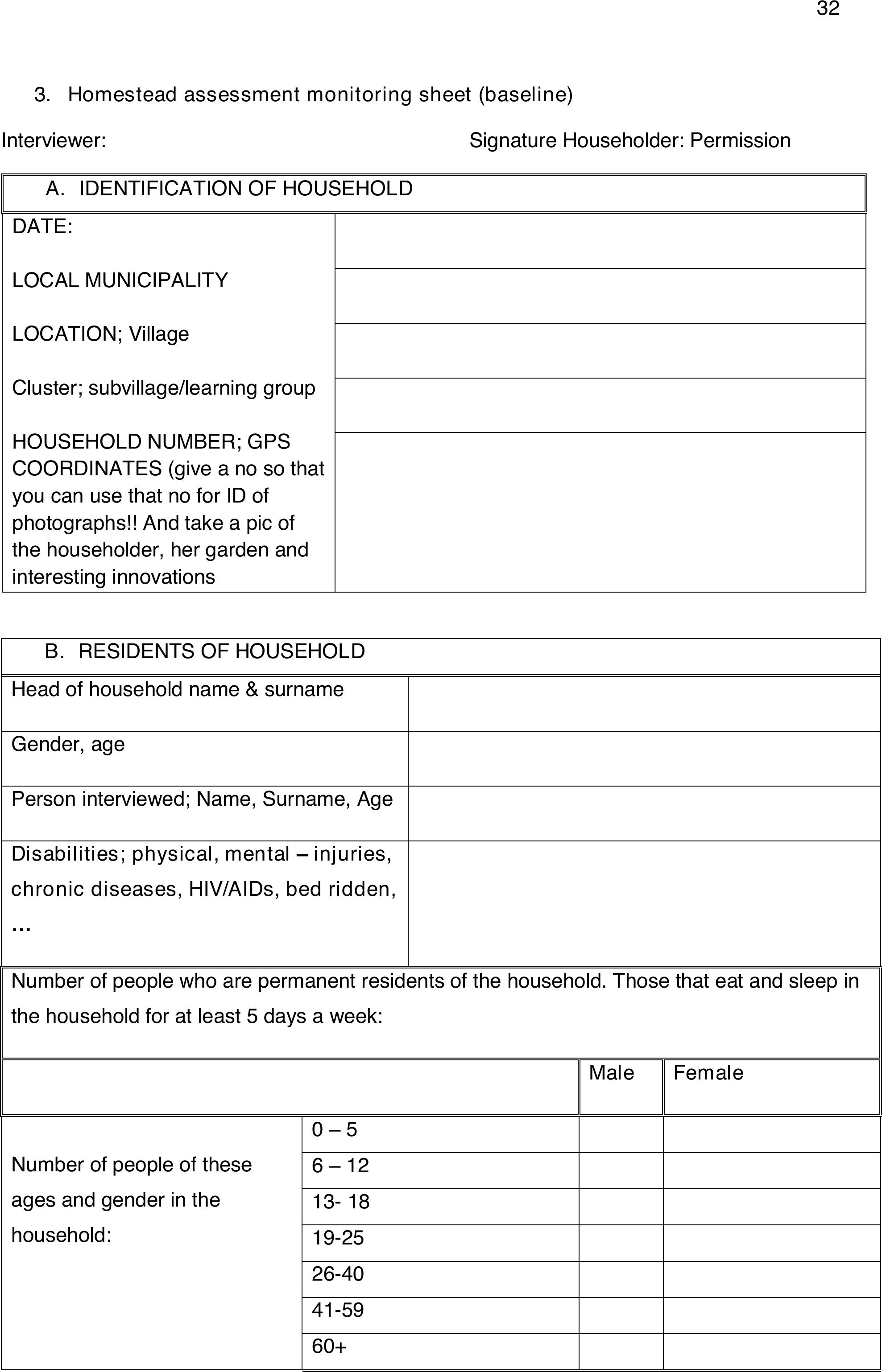
32
3. Homestead assessment monitoring sheet(baseline)
Interviewer: Signature Householder: Permission
A. IDENTIFICATION OF HOUSEHOLD
DATE:
LOCAL MUNICIPALITY
LOCATION; Village
Cluster; subvillage/learning group
HOUSEHOLD NUMBER; GPS
COORDINATES (give a no so that
you can use that no for ID of
photographs!! And take a pic of
the householder, her garden and
interesting innovations
B. RESIDENTS OF HOUSEHOLD
Head of household name & surname
Gender, age
Person interviewed; Name, Surname, Age
Disabilities; physical, mental –injuries,
chronic diseases, HIV/AIDs, bed ridden,
…
Number of people who are permanent residents of the household. Those that eat and sleep in
the household for at least 5 days a week:
Male
Female
Number of people of these
ages and gender in the
household:
0 –5
6 –12
13-18
19-25
26-40
41-59
60+
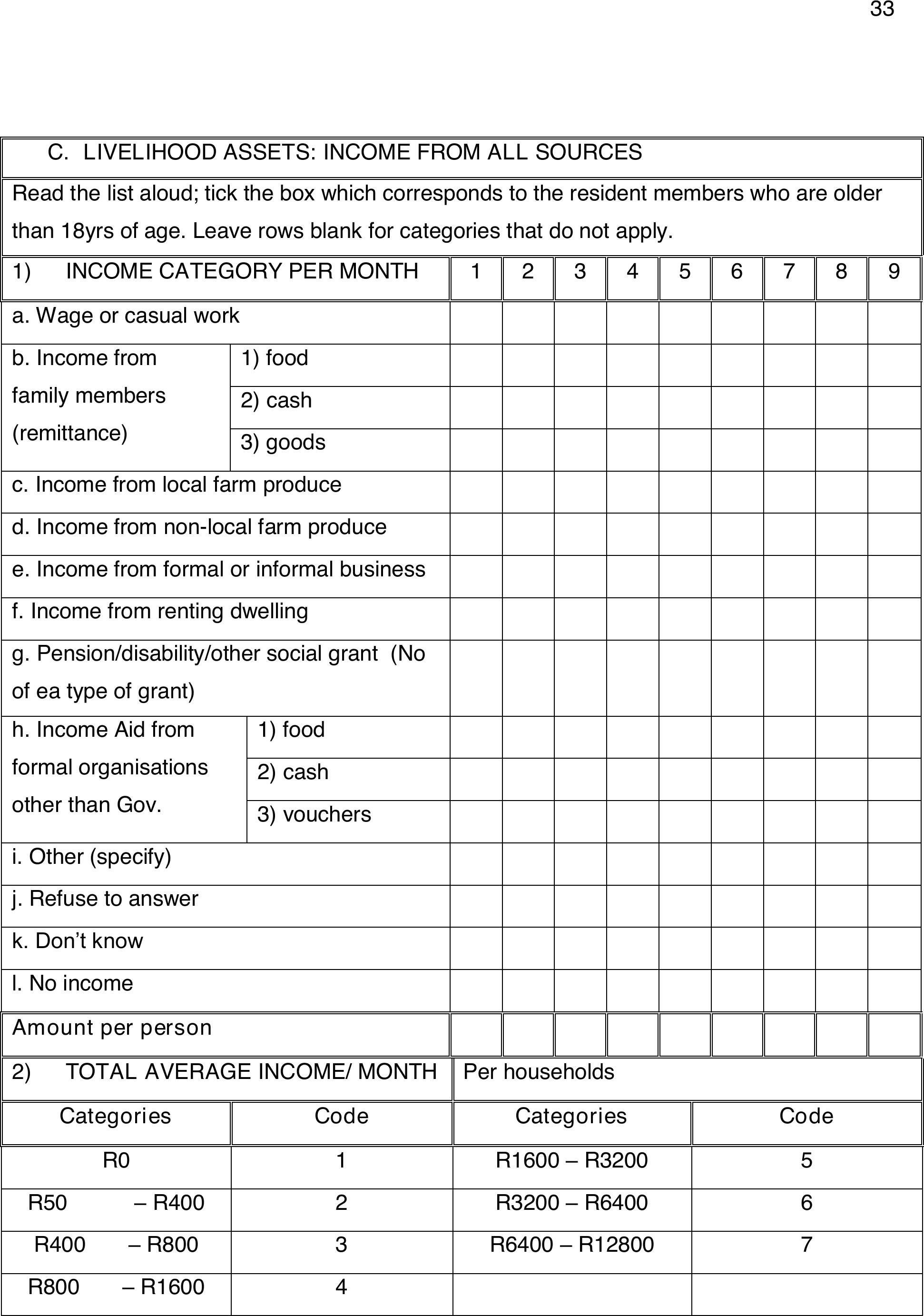
33
C. LIVELIHOOD ASSETS: INCOME FROM ALL SOURCES
Read the list aloud;tick the boxwhich corresponds to the resident members who are older
than 18yrs of age. Leave rows blank for categories that do not apply.
1) INCOME CATEGORY PER MONTH
1
2
3
4
5
6
7
8
9
a. Wage or casual work
b. Income from
family members
(remittance)
1) food
2) cash
3) goods
c. Income from local farm produce
d. Income from non-local farm produce
e. Income from formal or informal business
f. Income from renting dwelling
g. Pension/disability/other social grant(No
of ea type of grant)
h. Income Aid from
formal organisations
other than Gov.
1) food
2) cash
3) vouchers
i. Other (specify)
j. Refuse to answer
k. Don’t know
l. No income
Amount per person
2) TOTAL AVERAGE INCOME/MONTH
Per households
Categories
Code
Categories
Code
R0
1
R1600 –R3200
5
R50 –R400
2
R3200 –R6400
6
R400 –R800
3
R6400 –R12800
7
R800 –R1600
4

34
D. HOUSEHOLD ASSETS: EXPENSES FROM ALL SOURCES
Read the list aloud,circle the code that applies and complete the information for that row;
if an annual expense, give a monthly estimate.
3) EXPENSE CA TEGORY
Code
Amount
a. Food and groceries
1
Last
month
b. Utilities (water, electricity, etc)
2
Last
month
c. Transportation
3
Last
month
d. Savings
4
Last
month
e. Medical
5
Last
month
f. Education (school fees, uniforms,
etc.)
6
Last
month
g. Insurance (life, burial, etc.)
7
Last
month
h. Debt service/repayment
8
Last
month
i. Other (specify type of)
9
Last
month
j. NONE
10
k.Refuse to answer
11
Garden description and size: Include a map drawing of homestead with all aspects including
fencing, water sources, fruit, windbreaks, trees, vegetables, kraals. run off, dwellings, slope,
aspect, erosion: Proportion of vegetable garden in use:-cultivated within the last 6 months
(Put as a percentage)
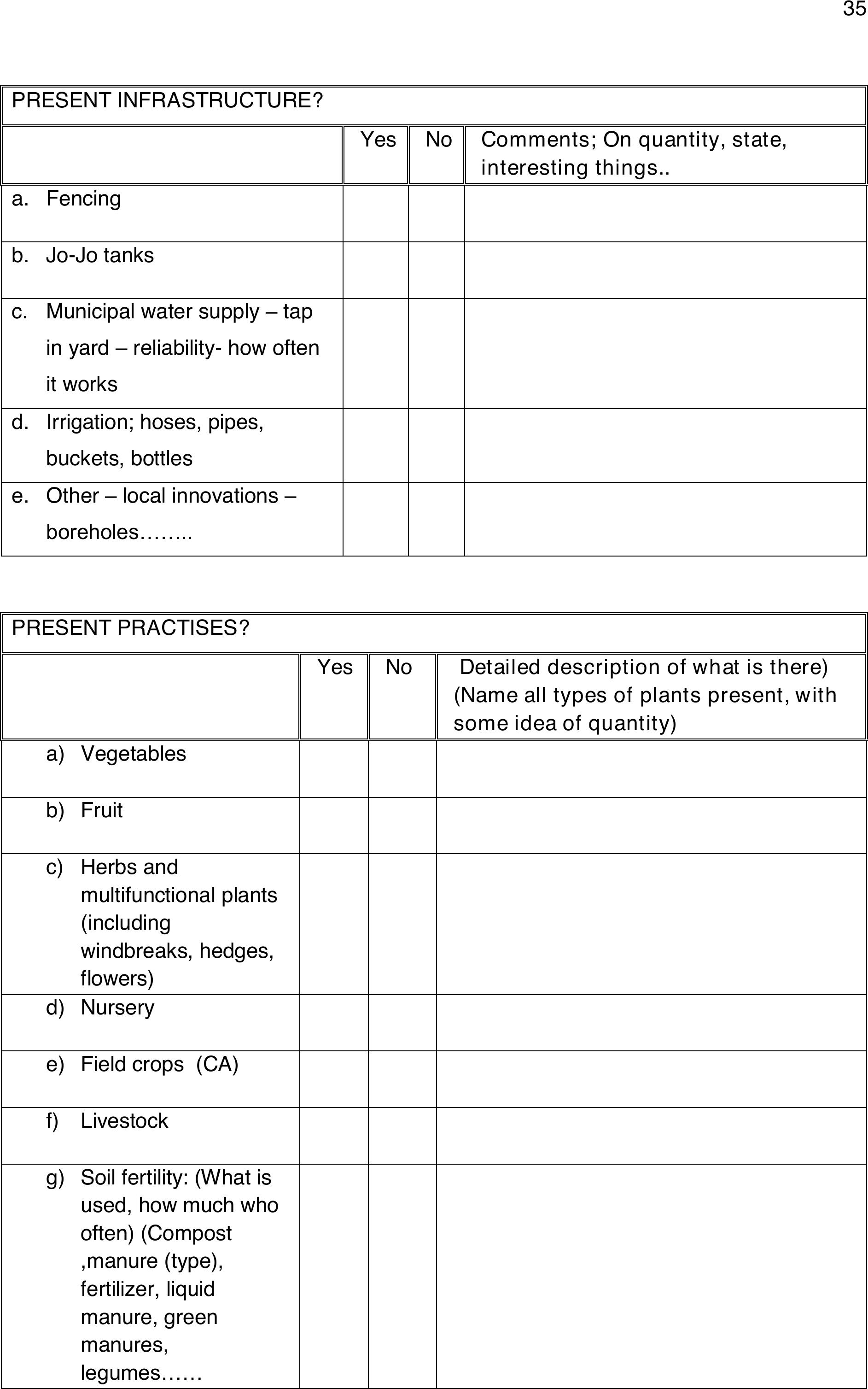
35
PRESENTINFRASTRUCTURE?
Yes
No
Comments; On quantity, state,
interesting things..
a. Fencing
b. Jo-Jo tanks
c.Municipal water supply –tap
in yard –reliability-how often
it works
d. Irrigation; hoses, pipes,
buckets, bottles
e. Other –local innovations –
boreholes……..
PRESENTPRACTISES?
Yes
No
Detailed description of what is there)
(Name all types of plants present, with
some idea of quantity)
a) Vegetables
b) Fruit
c)Herbs and
multifunctional plants
(including
windbreaks, hedges,
flowers)
d) Nursery
e) Field crops (CA)
f) Livestock
g) Soil fertility: (What is
used, how much who
often) (Compost
,manure(type),
fertilizer, liquid
manure, green
manures,
legumes……
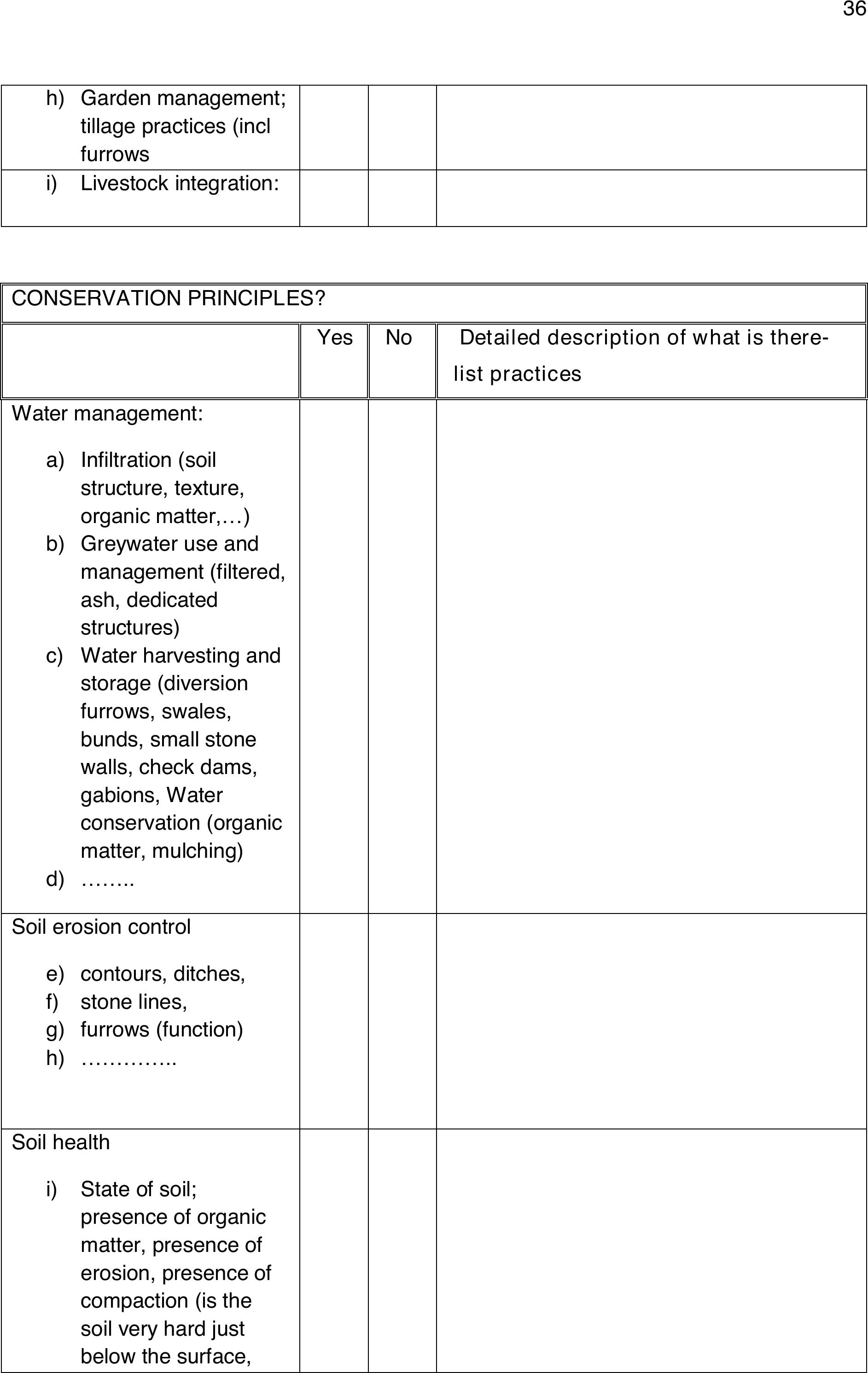
36
h) Garden management;
tillage practices (incl
furrows
i) Livestock integration:
CONSERVATION PRINCIPLES?
Yes
No
Detailed description of what is there-
list practices
Water management:
a) Infiltration (soil
structure, texture,
organic matter,…)
b) Greywater use and
management (filtered,
ash, dedicated
structures)
c)Water harvesting and
storage (diversion
furrows, swales,
bunds,small stone
walls, check dams,
gabions, Water
conservation (organic
matter, mulching)
d) ……..
Soil erosion control
e) contours, ditches,
f) stone lines,
g) furrows (function)
h) …………..
Soil health
i) State of soil;
presence of organic
matter, presenceof
erosion, presence of
compaction (is the
soil very hard just
below the surface,
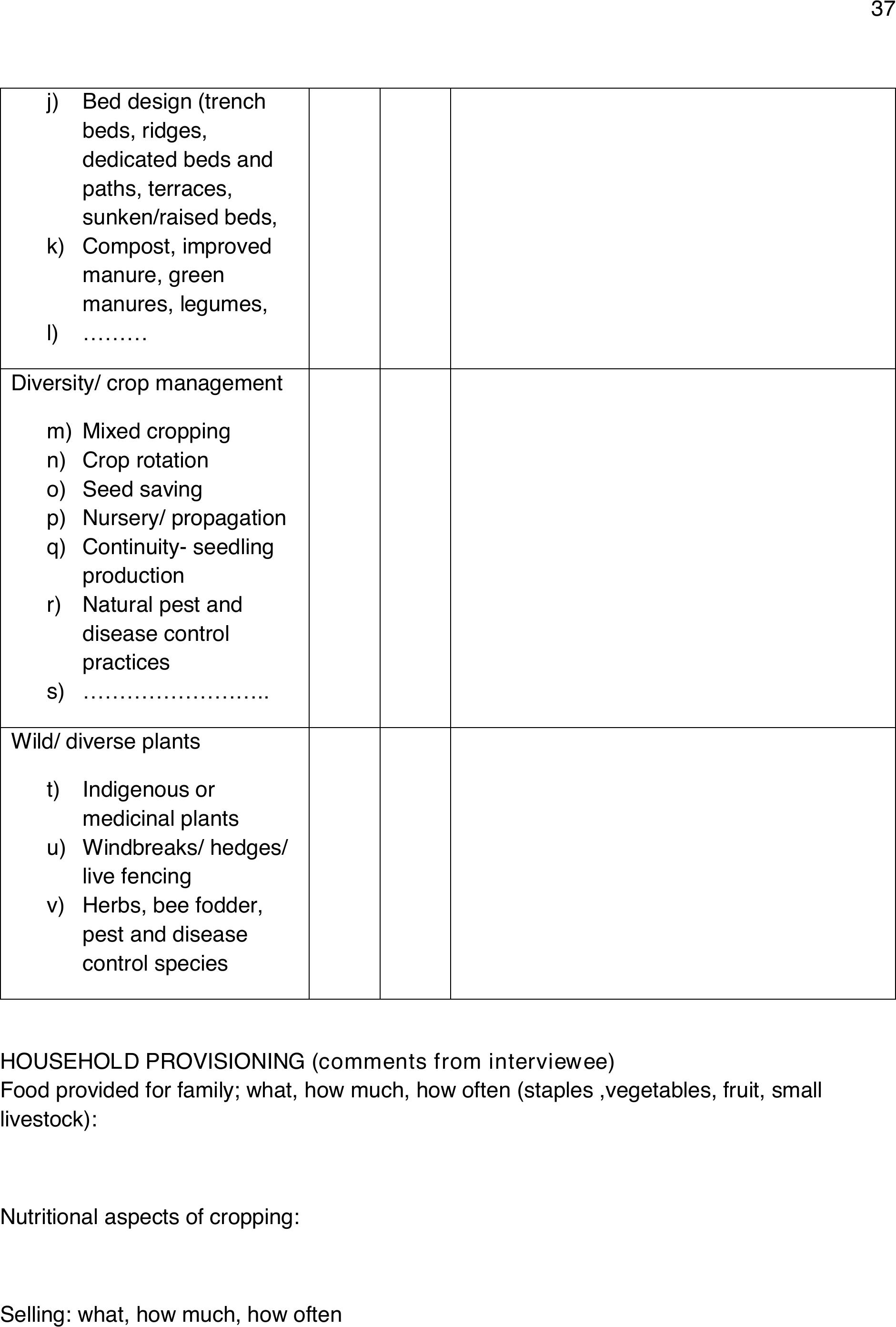
37
j) Bed design (trench
beds, ridges,
dedicated beds and
paths, terraces,
sunken/raised beds,
k)Compost, improved
manure, green
manures, legumes,
l) ………
Diversity/ crop management
m) Mixed cropping
n) Crop rotation
o) Seed saving
p) Nursery/ propagation
q) Continuity-seedling
production
r) Natural pest and
disease control
practices
s) ……………………..
Wild/ diverse plants
t) Indigenous or
medicinal plants
u) Windbreaks/ hedges/
live fencing
v) Herbs, bee fodder,
pest and disease
control species
HOUSEHOLD PROVISIONING (comments from interviewee)
Food provided for family; what, how much, howoften (staples,vegetables, fruit, small
livestock):
Nutritional aspects of cropping:
Selling:what, how much, how often
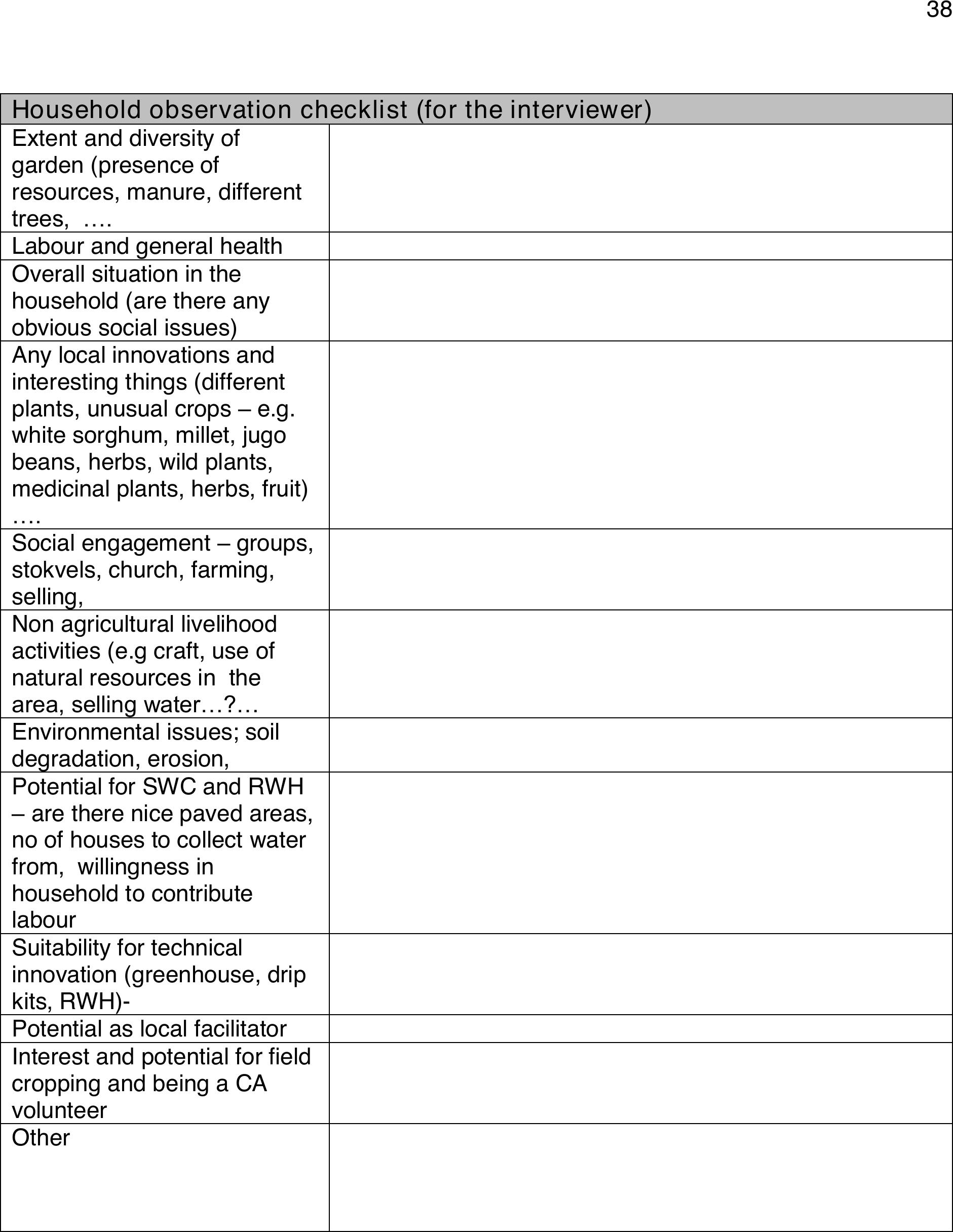
38
Household observation checklist(for the interviewer)
Extent and diversity of
garden (presence of
resources, manure, different
trees, ….
Labour and general health
Overall situation in the
household (are there any
obvious social issues)
Any local innovations and
interesting things (different
plants, unusual crops –e.g.
white sorghum, millet, jugo
beans, herbs, wild plants,
medicinal plants, herbs, fruit)
….
Social engagement –groups,
stokvels, church, farming,
selling,
Non agricultural livelihood
activities (e.g craft, use of
natural resources in the
area, selling water…?…
Environmental issues; soil
degradation, erosion,
Potential for SWC and RWH
–are there nicepaved areas,
no of houses to collect water
from, willingness in
household to contribute
labour
Suitability for technical
innovation (greenhouse, drip
kits, RWH)-
Potential as local facilitator
Interest andpotential for field
cropping and being a CA
volunteer
Other
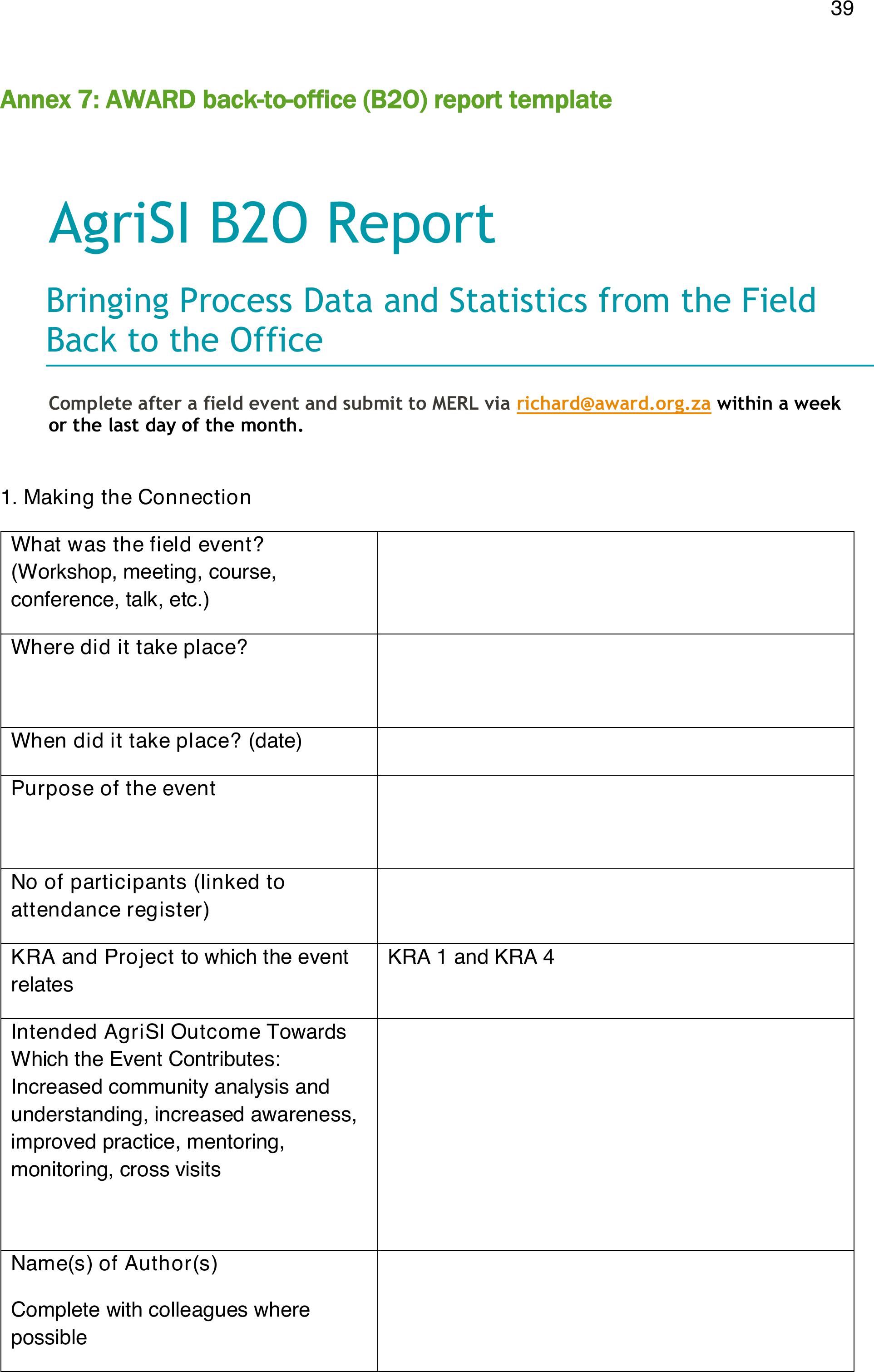
39
Annex 7: AWARD back-to-office (B2O) report template
1. Making the Connection
What was the field event?
(Workshop, meeting, course,
conference, talk, etc.)
Where did it take place?
When did it takeplace?(date)
Purpose of the event
No of participants (linked to
attendance register)
KRA and Projectto which the event
relates
KRA 1 and KRA 4
Intended AgriSIOutcome Towards
Which the Event Contributes:
Increased community analysis and
understanding, increased awareness,
improved practice,mentoring,
monitoring, crossvisits
Name(s) of Author(s)
Complete with colleagues where
possible
AgriSI B2O Report
Bringing Process Data and Statistics from the Field
Back to the Office
Complete after a field event and submit to MERL via richard@award.org.za within a week
or the last day of the month.
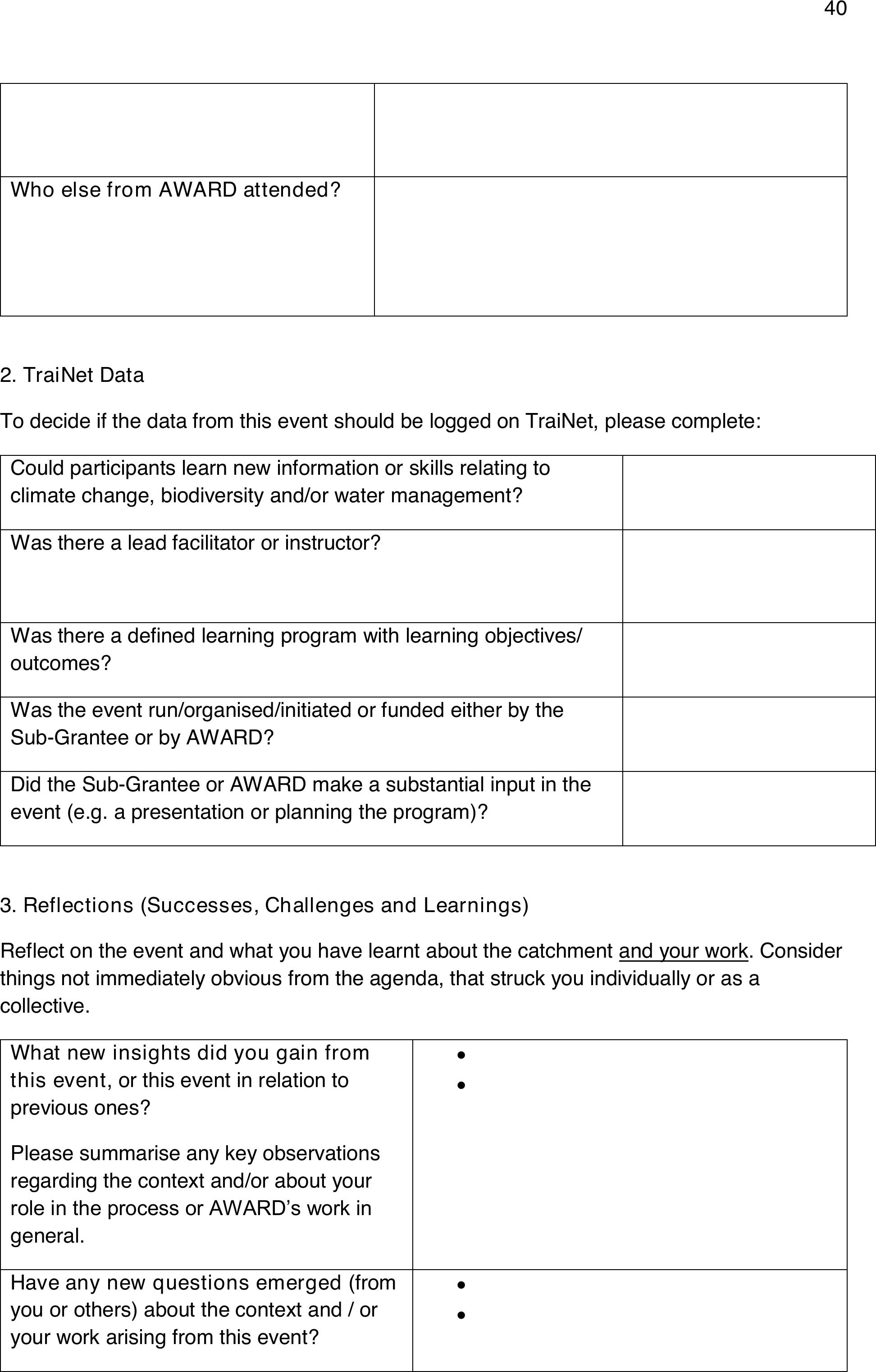
40
Who else from AWARD attended?
2. TraiNet Data
To decide if the data from this event should be logged on TraiNet, please complete:
Could participants learn newinformation or skills relating to
climate change, biodiversity and/or watermanagement?
Was there a lead facilitator or instructor?
Was there a defined learning program with learning objectives/
outcomes?
Was the event run/organised/initiated or funded either by the
Sub-Grantee or by AWARD?
Did the Sub-Granteeor AWARD make a substantial input in the
event (e.g. a presentationor planning the program)?
3. Reflections (Successes, Challenges and Learnings)
Reflect on the event and what you have learnt about the catchment and your work. Consider
things not immediately obvious from the agenda, that struck you individually or as a
collective.
What new insights did you gain from
this event, or this event in relation to
previous ones?
Please summariseany key observations
regarding the context and/or about your
role in the process or AWARD’s work in
general.
•
•
Have any new questions emerged(from
you or others) about the context and / or
your work arising from this event?
•
•
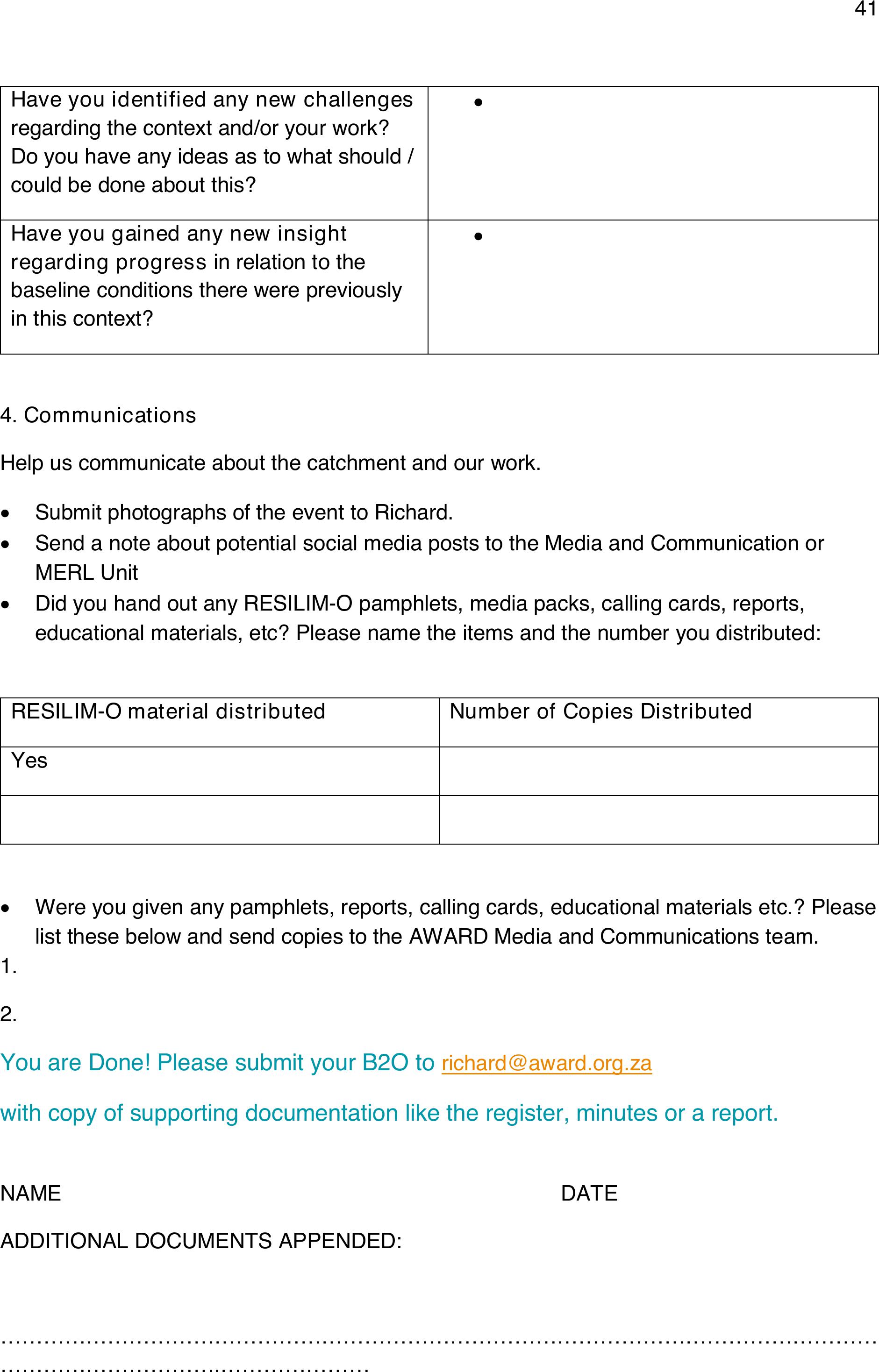
41
Have you identified any new challenges
regarding the context and/or your work?
Do you have any ideas as to what should /
could be done about this?
•
Have you gained any new insight
regarding progressin relation to the
baseline conditions there were previously
in this context?
•
4. Communications
Help us communicate about the catchment and our work.
•Submit photographs of the event to Richard.
•Send a note about potential social media posts to the Media and Communication or
MERL Unit
•Did you hand out any RESILIM-O pamphlets, media packs, calling cards, reports,
educational materials, etc? Please name the items and the number you distributed:
RESILIM-O material distributed
Number of Copies Distributed
Yes
•Were you given any pamphlets, reports, calling cards, educational materials etc.? Please
list these below and send copies to the AWARD Media and Communications team.
1.
2.
You are Done! Please submit your B2O torichard@award.org.za
with copy of supporting documentation like the register, minutes or a report.
NAME DATE
ADDITIONAL DOCUMENTS APPENDED:
……………………………………………………………………………………………………………
………………………….…………………